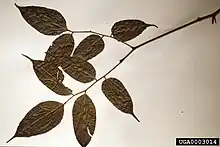Craibia
Craibia is a genus of flowering plants in the family Fabaceae. It contains nine species native to sub-Saharan Africa, ranging from Liberia east to the Horn of Africa and south to the Cape Provinces of South Africa.[1]
| Craibia | |
|---|---|
 | |
| Craibia zimmermannii | |
| Scientific classification | |
| Kingdom: | Plantae |
| Clade: | Tracheophytes |
| Clade: | Angiosperms |
| Clade: | Eudicots |
| Clade: | Rosids |
| Order: | Fabales |
| Family: | Fabaceae |
| Subfamily: | Faboideae |
| Tribe: | Millettieae |
| Genus: | Craibia Harms & Dunn (1911) |
| Species[1] | |
|
9; see text | |
Craibia was named for William Grant Craib (1882–1933), a British botanist who was an Assistant for India at Kew and a professor at Aberdeen University, the author of Contributions to the Flora of Siam (1912) and Florae siamensis enumeratio (1925). The genus Craibia was published in 1911 by British botanist Stephen Troyte Dunn.[2][3]
Species
Nine species are accepted:[1]
- Craibia affinis (De Wild.) De Wild.
- Craibia atlantica Dunn
- Craibia brevicaudata (Vatke) Dunn
- Craibia brownii Dunn
- Craibia grandiflora (Micheli) Baker f.
- Craibia laurentii (De Wild.) De Wild.
- Craibia lujae De Wild.
- Craibia simplex Dunn
- Craibia zimmermannii (Harms) Dunn
References
Wikispecies has information related to Craibia.
Wikimedia Commons has media related to Craibia.
- Craibia Harms & Dunn. Plants of the World Online. Retrieved 16 August 2023.
- (PlantZAfrica.com; CRC World Dictionary of Plant Names).
- The Eponym Dictionary of Southern African Plants. Plant Names C-F
This article is issued from Wikipedia. The text is licensed under Creative Commons - Attribution - Sharealike. Additional terms may apply for the media files.